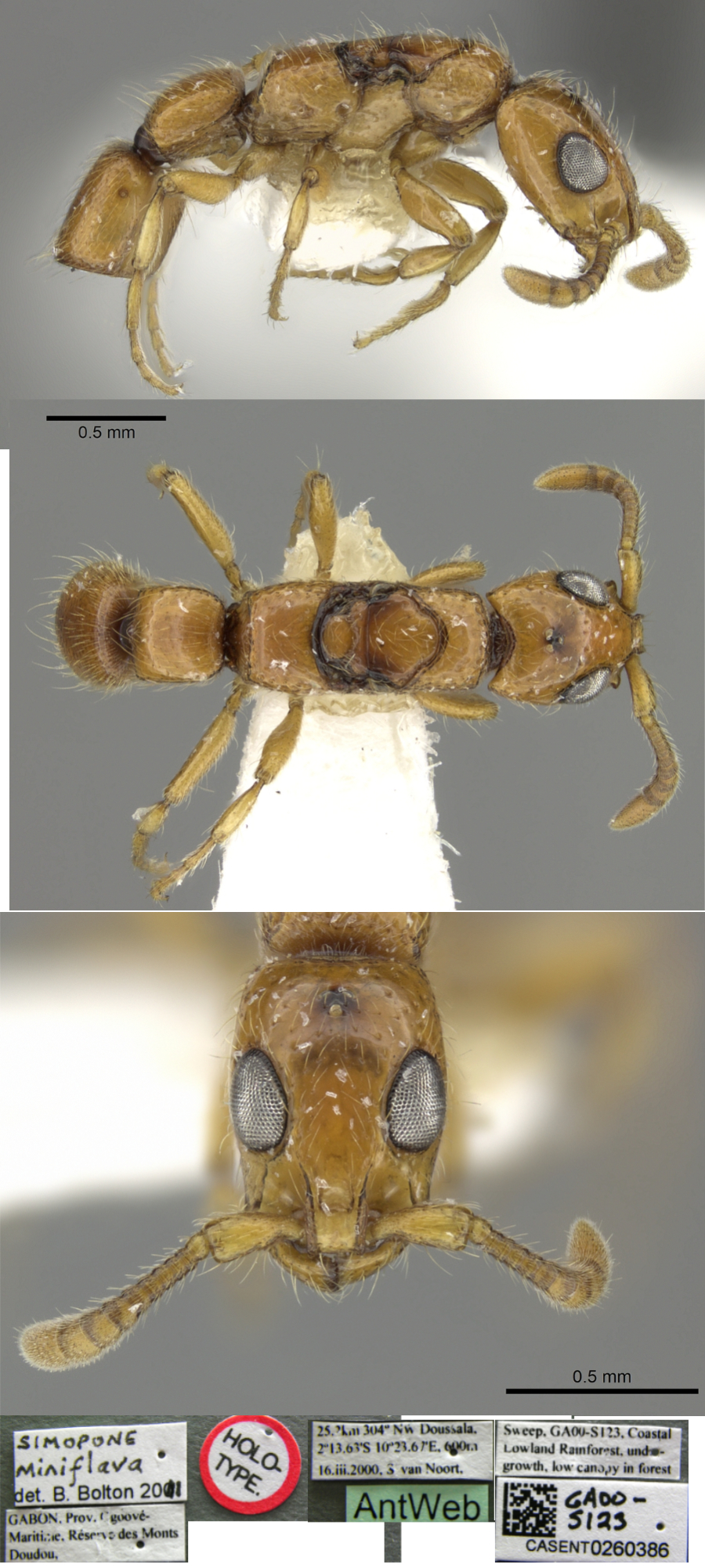Simopone miniflava Bolton & Fisher
  Type location Gabon (Bolton
& Fisher, 2012: 33, illustrated, queen) Prov. Ogooué-Maritime
[Ogoové-Maritime],
Rés.
Monts Doudou, 25.2 km 304° NW Doussala, 2°13.63’S, 10°23.67’E, 600 m,
16.iii.2000, sweep GA00-S123, coastal lowland rainforest, undergrowth,
low canopy in forest (S. van Noort) (CASC) Type location Gabon (Bolton
& Fisher, 2012: 33, illustrated, queen) Prov. Ogooué-Maritime
[Ogoové-Maritime],
Rés.
Monts Doudou, 25.2 km 304° NW Doussala, 2°13.63’S, 10°23.67’E, 600 m,
16.iii.2000, sweep GA00-S123, coastal lowland rainforest, undergrowth,
low canopy in forest (S. van Noort) (CASC)  . .
|
HOLOTYPE
QUEEN (dealate gyne). HL 0.84, HW 0.56, SL 0.27, EL 0.28, PW 0.45, AIIW
0.42, AIIL 0.44, AIIIW 0.52, AIIIL 0.58, WL 1.14, MFL 0.48, CI 67, SI
48, EL/HW 0.50, EP 1.07, AIIW/AIIL 0.95, AIIIW/AIIIL 0.90.
With head in full-face view the midpoints of the outer margins of the
eyes distinctly interrupt the outlines of the sides of the head. ES
0.25 and width of head across broadest part of eyes 0.58; minimum
distance between eyes 0.26. Frontal carinae extend back to level of
anterior margins of eyes and are weakly divergent posteriorly. Cephalic
dorsum with extremely sparse scattered vestiges of shallow punctures;
without trace of longitudinal ground sculpture. Leading edge of scape
with a few setae, inclined toward the scape apex. Sides of head below
and behind eyes with projecting short setae, inclined anteriorly.
Cephalic dorsum with numerous short, curved setae and also with two
much longer, posteriorly curved setae above each eye. Ventral surface
of head with numerous short setae. Mesosoma in dorsal view with
mesoscutum 0.45 maximum width, 0.33 maximum length. Anterior margin of
pronotum without a defined carina; the junction of anterior and dorsal
surfaces marked by a blunt angle and a weak, broken margination that
appears to consist of the anterior edges of a line of shallow
punctures. Propodeum with an angle between dorsum and declivity,
without a carina, but a low carina present on each side of declivity.
Entire dorsum of mesosoma with very sparse broad shallow punctures,
without ground sculpture between them. Mesopleuron without a transverse
sulcus. Propodeal declivity smooth. In profile, dorsal surfaces of
mesosoma and abdominal tergites AII and AIII with numerous short curved
setae. Standing setae are present on middle and hind femora and tibiae.
AII (petiole) in dorsal view with a weak transverse carina both
anteriorly and posteriorly. Sides of AII straight and parallel for most
of their length, slightly narrowed immediately behind the anterior
carina; width across AII is constant for most of its length. Dorsum of
AII with weak vestiges of punctures, mostly smooth. On AIII the
punctures are better defined than on AII but are widely separated;
without ground sculpture on either segment. Abdominal segments behind
AIII missing. AII and AIII longer than broad. Head, body and appendages
entirely yellow, scapes and funiculi not contrasting with the head
capsule. The only traces of darker colour occur as a small patch
between the ocelli, around the flight sclerites and on the helcium.
Holotype queen, Gabon: Ogoové-Maritime, Réserve des Monts Doudou,
25.2 km 304° NW Doussala, 2°13.63’S, 10°23.67’E, 600 m, 16.iii.2000,
sweep GA00-S123, coastal lowland rainforest, undergrowth, low can- opy
in forest (S. van Noort) (CASC).
Holotype is badly damaged, with abdominal segments after AIII missing.
This small, uniformly yellow species is quite different from any other
in the group. The combination of its colour, complete lack of cephalic
ground sculpture, and mostly parallel-sided AII and dimensions render
it immediately recognisable. Coupled with this, the lack of a
distinct mesopleural transverse sulcus is unique among the few known
queens of the schoutedeni
group.
|
 The photomontage of the
holotype queen is
collated from http://www.antweb.org/specimen.do?name=casent0260386 The photomontage of the
holotype queen is
collated from http://www.antweb.org/specimen.do?name=casent0260386
|
|